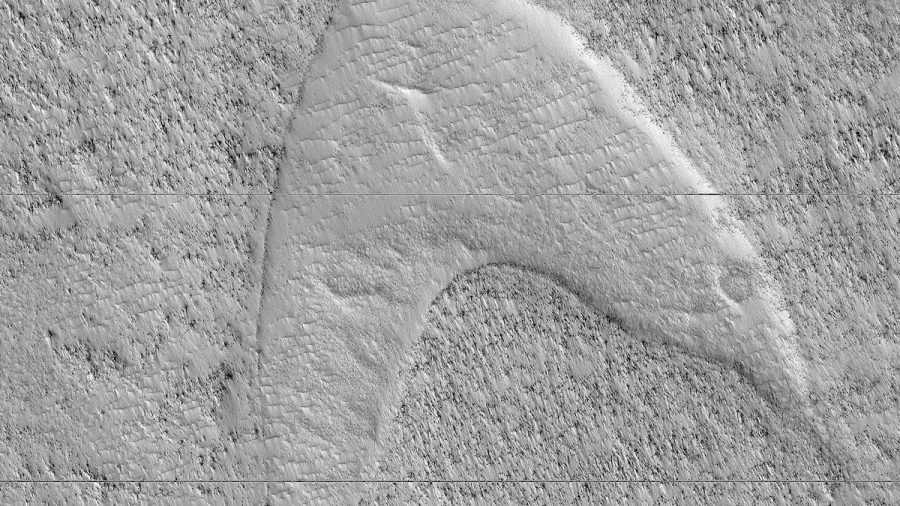It may be time to hail Starfleet and see whether they’ve set up a base on Mars.
NASA’s Mars Reconnaissance Orbiter captured an image of a strange chevron on the Martian surface that looks similar to the symbol for “Star Trek’s” Starfleet, an organization of space exploration, diplomacy, research, defense, and peacekeeping.
But how did it end up on the Red Planet?
The shapes were found in the southeast Hellas Planitia region of Mars, created by wind, lava, and dunes. At some point in Martian history, crescent-shaped dunes were in the area. An eruption sent lava spilling out, moving around the dunes but not covering them. As the lava cooled, the dunes pointed up like islands.
But they were still dunes, so the wind could move them, and the dunes essentially migrated. Their footprints, called “dune casts,” were left behind in the lava field.
So, no, it’s not an alien habitat or Starfleet base—unless the United Federation of Planets has some explaining to do.
By Ashley Strickland
![]()
Long-Distance Trip: NASA Opening Space Station to Visitors
NEW YORK—You’ve heard about the International Space Station for years. Want to visit?
NASA announced on June 7 that the orbiting outpost is now open for business to private citizens, with the first visit expected to be as early as next year.
Today starts a new day in low-Earth orbit as we unlock the @Space_Station’s potential as a platform for companies to engage in commercial profit-making activities and we welcome private astronauts to visit on U.S. vehicles. Get more details: https://t.co/lJnIlxaii7 pic.twitter.com/8sbi1lEzIn
— NASA (@NASA) June 7, 2019
There is a catch, though: You’ll need to raise your own cash, and it won’t be cheap.
Travelers will pay an estimated $58 million for a round-trip ticket. And accommodations will run about $35,000 per night, for trips of up to 30 days long.
NASA announces details about plans for commercial and marketing activities aboard the International Space Station, with a long-term goal to achieve a robust economy in low-Earth orbit. More photos from the briefing in NewYork: https://t.co/31FjLSItdX pic.twitter.com/JvSEVDcxCO
— NASA HQ PHOTO (@nasahqphoto) June 7, 2019
“But it won’t come with any Hilton or Marriott points,” said NASA’s chief financial officer Jeff Dewit during a news conference at Nasdaq in New York City.
Travelers don’t have to be U.S. citizens. People from other countries will also be eligible, as long as they fly to the space station on a U.S.-operated rocket.

Depending on the market, the agency will allow up to two visitors per year, for now. And the private astronauts will have to meet the same medical standards, training and certification procedures as regular crew members.
The space station has welcomed tourists before by way of Russian rockets. In 2001, California businessman Dennis Tito became the first visitor by paying for a journey and several others have followed.
Who was the 1st #spacetourist?
In 2001, American Dennis Tito self-funded his almost 8 days in space visiting the @Space_Station. Any guess how much the trip cost him? #funfacts #quiz #HumanSpaceFlight pic.twitter.com/cBPjM1iIIu— UNOOSA (@UNOOSA) March 30, 2019
Friday’s announcement marks the first time NASA is allowing private astronauts on board. The program is part of NASA’s efforts to open the station to private industries, which the agency hopes will inherit the orbiting platform someday.

Eventually, the space station will become too expensive for the government to maintain, said Bill Gerstenmaier, a NASA’s associate administrator. So the idea is to let the private sector start using the station now and perhaps eventually take it over, he said.
The NASA officials said some revenue from commercial activities will help the agency focus its resources on returning to the moon in 2024, a major goal of the Trump administration. The agency said this will also reduce the cost to U.S. taxpayers for this next lunar mission.
The Associated Press contributed to this report.


